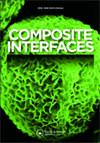Effect of Ni addition on the behavior of dissimilar A356-AZ91/CeO 2 aluminum-magnesium based composite fabricated by friction stir process technique
IF 2.4
4区 材料科学
Q3 MATERIALS SCIENCE, COMPOSITES
引用次数: 4
Abstract
ABSTRACTIn the present study, the Behavior of Dissimilar A356-AZ91/CeO2 Aluminum-Magnesium Based Composite Fabricated by Friction Stir Process Technique was observed. The Macrostructure of A356-AZ91/5%CeO2/2% Ni showed a defect-free and crack-free composite. Microstructural examination revealed that the FSP effectively distributed the CeO2 particles within the matrix, resulting in a refined microstructure. Tensile strength of A356-AZ91 matrix material was improved by about 38.04% after the addition of 5% CeO2. However, with the 2% Ni addition to A356-AZ91/5% CeO2 composite displaying further enhancement. The addition of 5% CeO2 and 2% Ni to the A356-AZ91 alloy through FSP showed a 44.78% improvement in tensile strength. There was an improvement in the hardness after adding the 2% Ni- 5% CeO2 particles was found 41.66%. Hardness of A356-AZ91-5% CeO2 was improved only by about 28.33% without addition of 2% Ni. Wear testing of aluminum composite was carried out using a pin-on-disc apparatus. The wear rate of A356-AZ91 alloy decreased by about 70% after the addition of the 2% Ni- 5% CeO2 particles. However, wear rate of A356-AZ91 alloy decreased only by about 61.66% after the addition of 5% CeO2 particles.KEYWORDS: Interfacial layermacrostructureFSP techniquefatigue strengthwear Disclosure statementNo potential conflict of interest was reported by the author(s).Ni添加量对搅拌摩擦法制备不同A356-AZ91/ ceo2铝镁基复合材料性能的影响
摘要:研究了采用搅拌摩擦法制备的不同种类的A356-AZ91/CeO2铝镁基复合材料的性能。A356-AZ91/5%CeO2/2% Ni的宏观组织表现为无缺陷、无裂纹的复合材料。显微组织分析表明,FSP有效地将CeO2颗粒分布在基体内,形成了精细的微观结构。添加5% CeO2后,A356-AZ91基体材料的抗拉强度提高约38.04%。而在A356-AZ91/5% CeO2中添加2% Ni后,复合材料表现出进一步的增强。通过FSP向A356-AZ91合金中添加5%的CeO2和2%的Ni,拉伸强度提高44.78%。加入2% Ni- 5% CeO2颗粒后,合金的硬度提高了41.66%。在不添加2% Ni的情况下,A356-AZ91-5% CeO2合金的硬度仅提高了约28.33%。采用针盘式磨损试验机对铝复合材料进行了磨损试验。添加2% Ni- 5% CeO2颗粒后,A356-AZ91合金的磨损率降低了约70%。而加入5% CeO2颗粒后,A356-AZ91合金的磨损率仅下降了约61.66%。关键词:界面层宏观结构疲劳强度磨损披露声明作者未报告潜在利益冲突。
本文章由计算机程序翻译,如有差异,请以英文原文为准。
求助全文
约1分钟内获得全文
求助全文
来源期刊

Composite Interfaces
工程技术-材料科学:复合
CiteScore
5.00
自引率
3.80%
发文量
58
审稿时长
3 months
期刊介绍:
Composite Interfaces publishes interdisciplinary scientific and engineering research articles on composite interfaces/interphases and their related phenomena. Presenting new concepts for the fundamental understanding of composite interface study, the journal balances interest in chemistry, physical properties, mechanical properties, molecular structures, characterization techniques and theories.
Composite Interfaces covers a wide range of topics including - but not restricted to:
-surface treatment of reinforcing fibers and fillers-
effect of interface structure on mechanical properties, physical properties, curing and rheology-
coupling agents-
synthesis of matrices designed to promote adhesion-
molecular and atomic characterization of interfaces-
interfacial morphology-
dynamic mechanical study of interphases-
interfacial compatibilization-
adsorption-
tribology-
composites with organic, inorganic and metallic materials-
composites applied to aerospace, automotive, appliances, electronics, construction, marine, optical and biomedical fields
 求助内容:
求助内容: 应助结果提醒方式:
应助结果提醒方式:


